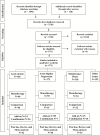The International College of Neuro-Psychopharmacology (CINP) Treatment Guidelines for Bipolar Disorder in Adults (CINP-BD-2017), Part 2: Review, Grading of the Evidence, and a Precise Algorithm
- PMID: 27816941
- PMCID: PMC5409012
- DOI: 10.1093/ijnp/pyw100
The International College of Neuro-Psychopharmacology (CINP) Treatment Guidelines for Bipolar Disorder in Adults (CINP-BD-2017), Part 2: Review, Grading of the Evidence, and a Precise Algorithm
Abstract
Background: The current paper includes a systematic search of the literature, a detailed presentation of the results, and a grading of treatment options in terms of efficacy and tolerability/safety.
Material and methods: The PRISMA method was used in the literature search with the combination of the words 'bipolar,' 'manic,' 'mania,' 'manic depression,' and 'manic depressive' with 'randomized,' and 'algorithms' with 'mania,' 'manic,' 'bipolar,' 'manic-depressive,' or 'manic depression.' Relevant web pages and review articles were also reviewed.
Results: The current report is based on the analysis of 57 guideline papers and 531 published papers related to RCTs, reviews, posthoc, or meta-analysis papers to March 25, 2016. The specific treatment options for acute mania, mixed episodes, acute bipolar depression, maintenance phase, psychotic and mixed features, anxiety, and rapid cycling were evaluated with regards to efficacy. Existing treatment guidelines were also reviewed. Finally, Tables reflecting efficacy and recommendation levels were created that led to the development of a precise algorithm that still has to prove its feasibility in everyday clinical practice.
Conclusions: A systematic literature search was conducted on the pharmacological treatment of bipolar disorder to identify all relevant random controlled trials pertaining to all aspects of bipolar disorder and graded the data according to a predetermined method to develop a precise treatment algorithm for management of various phases of bipolar disorder. It is important to note that the some of the recommendations in the treatment algorithm were based on the secondary outcome data from posthoc analyses.
Keywords: anticonvulsants; antidepressants; antipsychotics; bipolar depression; bipolar disorder; clinical trials; evidence-based guidelines; lithium; mania; mood stabilizers; treatment.
© The Author 2016. Published by Oxford University Press on behalf of CINP.
Figures
References
-
- (1997) Expert consensus guidelines are released for the treatment of bipolar disorder. Consensus Development Conferences. Am Fam Physician 55:1447–1449. - PubMed
-
- (2008) International Consensus Group on the evidence-based pharmacologic treatment of bipolar I and II depression. J Clin Psychiatry 69:1632–1646. - PubMed
-
- (2009) NCT00329108 study results. In.
-
- AACAP (1997) AACAP official action. Practice parameters for the assessment and treatment of children and adolescents with bipolar disorder. J Am Acad Child Adolesc Psychiatry 36:138–157. - PubMed
Publication types
MeSH terms
Substances
LinkOut - more resources
Full Text Sources
Other Literature Sources
Medical



